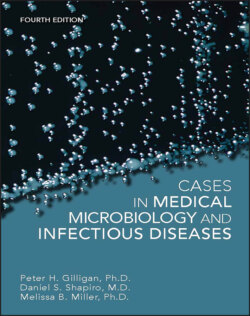Читать книгу Cases in Medical Microbiology and Infectious Diseases - Melissa B. Miller - Страница 34
Оглавление
SECTION ONE
UROGENITAL TRACT INFECTIONS
INTRODUCTION TO SECTION I
We begin this text with a discussion of infections of the genitourinary tract for two reasons. First, the number of microorganisms that frequently cause infection in these organs is somewhat limited. Second, urinary tract infections (UTIs) and sexually transmitted infections (STIs) are two of the most common reasons why young adults, particularly women, consult a physician. UTIs are examples of endogenous infections, i.e., infections that arise from the patient’s own microbiota. In the case of UTIs, the microbes generally originate in the gastrointestinal tract and colonize the periurethral region before ascending the urethra to the bladder. STIs are exogenous infections; i.e., the infectious agent is acquired from a source outside the body. In the case of STIs, these agents are acquired by sexual contact.
UTIs are much more common in women than in men for a number of reasons. The urethra is shorter in women than in men, and straight rather than curved as in men, making it easier for microbes to ascend to the bladder. Prostatic secretions have antibacterial properties, which further protects the male. The periurethral epithelium in women, especially women with recurrent UTIs, is more frequently colonized with microorganisms that cause UTIs. It should also be noted that the incidence of UTIs is higher in sexually active women, as coitus can introduce organisms colonizing the periurethral region into the urethra. The incidence of nosocomial UTIs, however, is similar in women and men. In these infections, catheterization is the major predisposing factor.
The incidence of STIs is similar in both heterosexual men and women; however, the morbidity associated with these infections tends to be much greater in women. In particular, irreversible damage to reproductive organs, caused by both Chlamydia trachomatis and Neisseria gonorrhoeae, is all too common. Infections with these two organisms are almost always symptomatic in males, though the few men who do not have symptoms can be responsible for infecting many partners. By contrast, a significant number of women may be infected asymptomatically at first. They may manifest signs and symptoms of infection only when they develop pelvic inflammatory disease, which can result in sterility. Fetal loss or severe perinatal infection may be caused by two other STI agents, herpes simplex virus and Treponema pallidum, the etiologic agent of syphilis.
Important agents of genitourinary tract infections are listed in Table 1. Only organisms in this table should be considered in your differential diagnosis for the cases in this section. You should note that not all organisms that can be spread sexually, such as hepatitis B virus and Entamoeba histolytica, are listed. This is because these infections do not have genitourinary tract manifestations.
TABLE I SELECTED GENITOURINARY TRACT PATHOGENS
| ORGANISM | GENERAL CHARACTERISTICS | SOURCE OF INFECTION | DISEASE MANIFESTATION |
| Bacteria | |||
| Actinomyces spp. | Anaerobic, Gram-positive bacilli | Endogenous | PIDa associated with intrauterine device usage |
| Aerococcus spp. | Catalase-negative, Gram-positive cocci | Endogenous | Community- or health care-associated UTIb |
| Bacteroides fragilis | Anaerobic, Gram-negative bacillus | Endogenous | Pelvic abscess |
| Chlamydia trachomatis | Obligate intracellular pathogen (does not Gram stain) | Direct sexual contact | Urethritis, cervicitis, PID |
| Enterobacter spp. | Lactose-fermenting, Gram-negative bacilli | Endogenous | Community- or health care-associated UTI |
| Enterococcus spp. | Catalase-negative, Gram-positive cocci | Endogenous | Health care-associated UTI |
| Escherichia coli | Lactose-fermenting, Gram-negative bacillus | Endogenous | Community- or health care-associated UTI |
| Haemophilus ducreyi | Fastidious, pleiomorphic, Gram-negative bacillus | Direct sexual contact | Chancroid (painful genital ulcer) |
| Klebsiella pneumoniae | Lactose-fermenting, Gram-negative bacillus | Endogenous | Community- or health care-associated UTI |
| Morganella morganii | Lactose-nonfermenting, Gram-negative bacillus | Endogenous | Community- or health care-associated UTI |
| Mycoplasma hominis | Lacks a cell wall (does not Gram stain) | Endogenous; direct sexual contact | Pyelonephritis, PID |
| Neisseria gonorrhoeae | Gram-negative, intracellular diplococcus | Direct sexual contact | Urethritis, cervicitis, PID |
| Proteus mirabilis | Lactose-nonfermenting, swarming, Gram-negative bacillus | Endogenous | Community- or health care-associated UTI |
| Pseudomonas aeruginosa | Lactose-nonfermenting, Gram-negative bacillus | Catheterization | Health care-associated UTI |
| Staphylococcus saprophyticus | Catalase-positive, Gram-positive coccus | Endogenous | Community-associated UTI |
| Treponema pallidum | Spirochete (does not Gram stain) | Direct sexual contact; vertical, mother to child | Chancre (painless genital ulcer); primary, secondary, tertiary syphilis; neonatal syphilis |
| Ureaplasma urealyticum | Lacks a cell wall (does not Gram stain) | Endogenous; direct sexual contact | Urethritis, urethroprostatitis, epididymitis, chorioamnionitis |
| Fungi | |||
| Candida spp. | Yeasts with pseudohyphae | Endogenous | Vaginitis, health care-associated UTI, balanitis |
| Parasites | |||
| Phthirus pubis | Crab lice | Direct sexual contact | Pubic hair infestation |
| Trichomonas vaginalis | Protozoan | Direct sexual contact | Vaginitis |
| Viruses | |||
| Adenoviruses | Nonenveloped DNA viruses | Exogenous exposure | Hemorrhagic cystitis |
| Herpes simplex viruses (HSV-1 and -2) | Enveloped DNA viruses | Direct sexual contact; vertical, mother to child | Recurrent genital ulcers, fetal/neonatal infections, encephalitis |
| Human immunodeficiency viruses (HIV-1 and -2) | Retroviruses | Direct sexual contact; blood and body fluids; vertical, mother to child | AIDS, neonatal infection, dementia |
| Human papillomavirus | Nonenveloped DNA virus | Direct sexual contact | Genital warts, cervical and anal carcinoma |
a PID, pelvic inflammatory disease.
b UTI, urinary tract infection.
